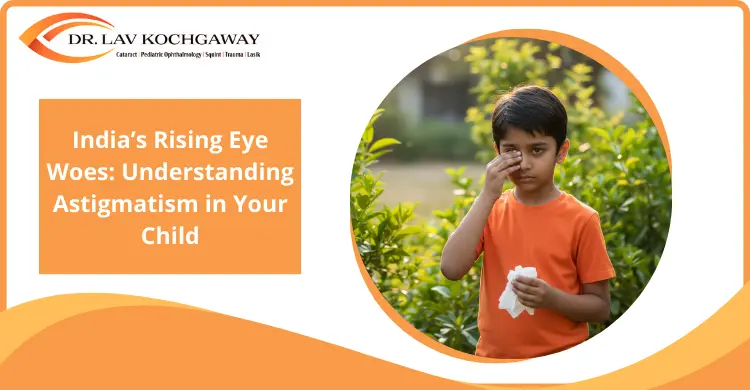
In India, growing academic demands and increased screen exposure are highlighting new concerns in kids’ eye problems. Among them is childhood astigmatism, a condition where the eye’s surface isn’t perfectly round, leading to blurred vision. Because children rarely complain, this condition can stay hidden, quietly impacting their confidence and learning. Fortunately, early detection through pediatric eye exams allows parents to step in at the right time, ensuring healthy vision and stronger overall development for their child.
Read on to find out how regular pediatric eye exams can prevent long‑term complications from astigmatism in children.
Astigmatism occurs when the cornea (the eye’s outermost layer) or the lens (inside the eye) isn’t perfectly curved. Normally, light enters the eye and focuses clearly on the retina, producing a sharp image. In astigmatism, the uneven curve scatters light, creating a blurred or stretched view of objects.
Types of astigmatism:
Think of it like trying to look through a spoon that’s slightly bent, straight lines may look wavy, and objects lose their crisp detail.
Contrary to popular belief, astigmatism is not just an adult problem. Studies show that nearly 25–30% of Indian children may have some degree of refractive error, including astigmatism. It can appear at birth or develop later as the eyes grow.
Myths vs. Facts:
The reasons vary, but common causes include:
Because astigmatism doesn’t always cause obvious discomfort, children may adapt silently, making it essential for parents to stay alert.
Kids with astigmatism might not say, “I can’t see,” but their behavior may reveal hidden struggles:
If these signs show up repeatedly, it’s time for a complete pediatric eye exam.
The best safeguard against vision problems is timely screening. Experts recommend starting eye exams between ages 3–5, before school begins.
Key diagnostic methods include:
While school screenings are helpful, they are not enough to catch subtle refractive errors like astigmatism.
Thankfully, childhood astigmatism is highly treatable. Depending on the age and needs of the child, options include:
With proper treatment, children can see clearly and participate in all activities without limitations.
If left unnoticed, astigmatism can lead to more than just blurry vision:
What’s encouraging is that all of these risks are preventable with regular eye care and corrective lenses.
Parents play the most crucial role in safeguarding children’s vision. Practical steps include:
Astigmatism in children may sound worrying, but it’s actually very manageable with timely care. The earlier it’s spotted, the easier it is to treat. As parents, your watchful eye and commitment to routine check‑ups can make all the difference, helping your child learn, play, and thrive without vision standing in the way.
Worried about your child’s vision? Don’t wait until blurry sight affects learning and confidence. Schedule a comprehensive pediatric eye exam with Dr. Lav Kochgaway, a trusted specialist in children’s eye health. Early detection makes all the difference, help your child see clearly and thrive every day.
Mild astigmatism in children can improve with age, but moderate to severe cases often persist. Regular eye exams track changes and guide treatment.
Signs include blurred or distorted vision, squinting, eye rubbing, headaches, or difficulty reading. A comprehensive eye exam by an eye specialist confirms it.
Astigmatism affects corneal curvature and vision clarity, while amblyopia is poor vision development in one eye, sometimes caused by uncorrected astigmatism.
Prescription glasses or contact lenses correct vision. In some cases, orthokeratology or refractive surgery may be considered, depending on age and severity.
Children should have a full eye exam every 1–2 years, or sooner if vision problems, squinting, or reading difficulties occur.